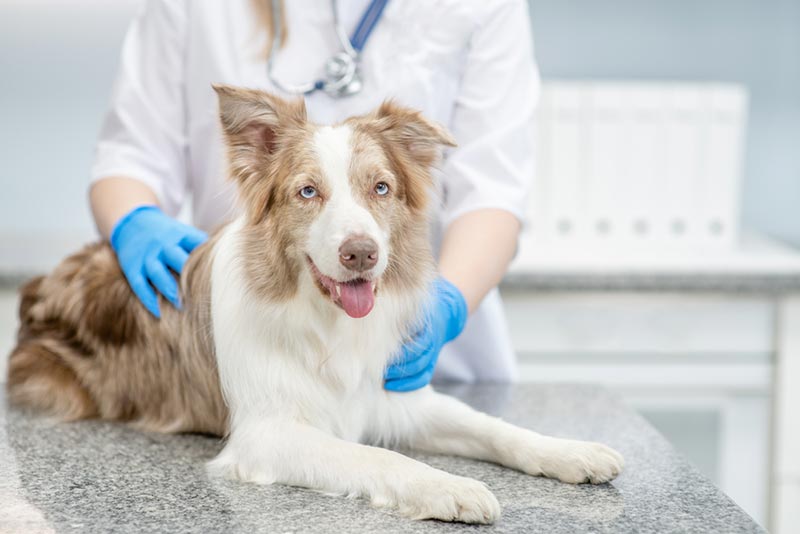
Click to Skip Ahead
Being faced with a choking dog can be terrifying, even for veterinary professionals. It is not something any of us wants to experience! Unfortunately, despite our best efforts to monitor what our dogs eat, choking sometimes happens.
Many of us are familiar with the Heimlich Maneuver, which is used to help people who are choking. The technique is similar for dogs but adjusted slightly for their anatomy. It is especially important to note that the approach is different for small and large dogs.
This article will discuss signs of choking, provide instructions for performing the Heimlich Maneuver in dogs, and offer tips for keeping your pup safe.
How to Recognize a Choking Dog
Your dog was just eating or chewing on something and now they look like they are struggling to breathe. How can you tell if they are truly choking? You may hear coughing or gagging but, in many cases, there will not be any obvious sounds because your dog’s airflow is significantly reduced or completely blocked.
Time is of the essence when a dog is choking, so it is important to try and dislodge the object at home. Taking care not to get bitten, open your dog’s mouth and look to see if you can identify the stuck object.
Performing the Heimlich Maneuver in Small Dogs: Step by Step
- Carefully place the dog on his or her back, in your lap, with their head away from your body.
- Place the palm of your hand just behind the center of the ribcage.
- Push firmly inward and upward (toward the dog’s head) for a total of 5 thrusts.
- Roll the dog onto his or her side and carefully look in their mouth to see if you have successfully dislodged the object.
Repeat the above steps until the dog stops choking, or cardiopulmonary resuscitation (CPR) becomes necessary (see below).

Performing the Heimlich Maneuver in Medium and Large Dogs: Step by Step
If the dog is standing up:
- Stand behind the dog (at their tail) and place your arms around their belly, with your hands meeting underneath in the middle.
- Join your hands together into a fist-shape and place them just behind the center of the ribcage.
- Pull firmly and sharply upward and forward (toward the dog’s head) a total of five times.
- Carefully open the dog’s mouth and check to see if the object has been dislodged.
Repeat the above steps until the dog stops choking, or cardiopulmonary resuscitation (CPR) becomes necessary (see below).
If the dog is laying down:
- Carefully roll the dog onto his or her side on the floor.
- Place one hand on the dog’s back and one hand on the underside of their belly.
- Use the hand on their belly to firmly squeeze upward and forward (toward the dog’s head) five times.
- Carefully open the dog’s mouth and check to see if the object has been dislodged.
- Repeat the above steps until the dog stops choking, or cardiopulmonary resuscitation (CPR) becomes necessary (see below).
When to Switch to Cardiopulmonary Resuscitation (CPR)
If the dog stops breathing and you cannot see or feel the heart beating or detect a pulse, switch to CPR. You can find a printable handout with detailed instructions here.
Ideally, someone should continue CPR while transporting the dog to the nearest veterinary emergency clinic. If possible, notify the clinic so they can be prepared to meet you on arrival.

What Should I Do After My Dog Stops Choking?
First of all, congratulate yourself for making it through an incredibly stressful situation and saving your dog’s life!
It is a good idea to have your pup checked out by a veterinarian as soon as possible, especially if they lost consciousness at any point. The vet will examine your dog thoroughly and may suggest a short hospital stay for monitoring, to make sure their airway has not been compromised by swelling in their throat. They will also check for any inadvertent injuries caused by performing the Heimlich Maneuver.
Your pup’s throat will definitely be irritated, and their abdomen is likely to be sore, so the veterinarian will probably prescribe some anti-inflammatory medication and recommend offering soft food for at least a few days.
How Can I Reduce My Dog’s Risk of Choking?
Conclusion
As a pet owner, it is a good idea to be prepared for a variety of emergencies. Consider taking a pet first aid course through one of the following organizations:
Hopefully, you will never be faced with a choking emergency. If your pup does get into trouble, however, they will be thankful that you know how to help!
Featured Image Credit: Milos Momcilovic, Shutterstock







